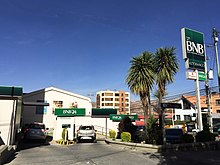Banco Nacional de Bolivia
[8] The bank was established in Cobija, an important port city located in the Litoral Department, Bolivia's only territory with access to the Pacific coast.
An additional head office was established in the Chilean city of Valparaíso, and thus BNB had dual legal addresses at the time.
The bank began providing financial assistance for the exploitation of nitrates in the Litoral region, particularly guano, used for fertilizer and to make saltpeter for the manufacture gunpowder.
Following the loss of the Bolivian Litoral, the bank moved its headquarters to the city of Sucre, where it held its first board of directors meeting.
Despite a central bank was established, Banco Nacional de Bolivia continued to offer significant financial assistance to the government.
150,000 to the state in order to finance the Bolivian campaign of the Treaty of Petrópolis and in 1932, the bank granted US$210,000 of its foreign reserves to support the efforts of the Chaco War.
The political instability that continued for the rest of the century presented many challenges to the fledgling Bolivian banking system.
After the 1952 Bolivian Revolution, the private sector finally overcame difficulties and challenges imposed by the central regimes and political groups in power.

